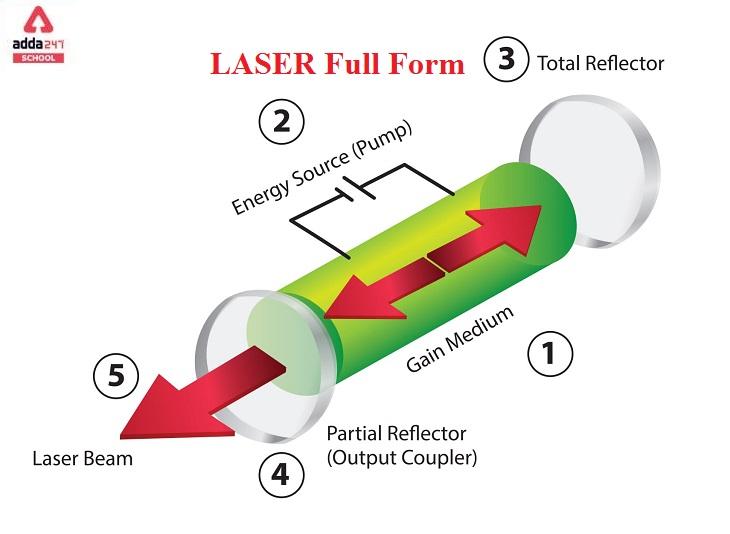Table of Contents
Laser Full Form
LASER Full Form: Light amplification by stimulated emission of radiation is the full form of the abbreviation, LASER. LASER is an electronic device, a device that produces light. This is electromagnetic radiation. This electromagnetic radiation is made through optical amplification. When explained in simple words, a laser is a tool that emits light through the process of optical amplification based on the stimulated emission of electromagnetic radiation.
According to the Cambridge Dictionary, “A device that produces a powerful narrow beam of light that can be used as a tool, for example to cut metal, to perform medical operations, etc. The beam of light is also known as a laser.”
Read About IT Full Form
Laser ka Full Form in Hindi
हिंदी में लेज़र का पूरा नाम विकिरण के उत्सर्जन से प्रेरित प्रकाश प्रवर्धन। लेज़र एक प्रकाश उत्सर्जक विद्युत उपकरण है। इसे विद्युत चुम्बकीय विकिरण कहा जाता है। इस विद्युत चुम्बकीय विकिरण को बनाने के लिए ऑप्टिकल प्रवर्धन का उपयोग किया जाता है। मूल शब्दों में, लेज़र एक ऐसा उपकरण है जो विद्युत चुम्बकीय विकिरण के उत्तेजित उत्सर्जन के आधार पर ऑप्टिकल प्रवर्धन की प्रक्रिया के माध्यम से प्रकाश का उत्सर्जन करता है।
Read About ITI Full Form
LASER Full Form in English: History
The laser is a result of Albert Einstein’s 1916 prediction that under the right conditions, atoms might release excess energy as light, either spontaneously or when stimulated by light. In 1928, German physicist Rudolf Walther Ladenburg detected stimulated emission for the first time, however it appeared to have no practical application at the time.
In 1951, Charles H. Townes, at Columbia University in New York City, devised a method for producing microwave-frequency stimulated emission. He presented a functioning apparatus at the end of 1953 that focuses on “excited” ammonia molecules in a resonant microwave cavity, where they radiated a pure microwave frequency. The device was named maser by Townes, which stands for “microwave amplification by stimulated emission of radiation.” The theory of maser operation was independently described by Aleksandr Mikhaylovich Prokhorov and Nikolay Gennadiyevich Basov of the P.N. Lebedev Physical Institute in Moscow. The Nobel Prize in Physics was awarded to all three of them in 1964 for their contribution.
In the mid-1950s, there was a spurt of maser research, although masers only had a restricted range of uses like low-noise microwave amplifiers and atomic clocks.
In 1957, Townes recommended to Arthur L. Schawlow (then at Bell Laboratories), his brother-in-law and a former postdoctoral student at Columbia University, that they try to extend maser action to the considerably shorter wavelengths of infrared or visible light. Townes also met with Gordon Gould, a Columbia University graduate student who swiftly developed his own laser concepts. Townes and Schawlow published their ideas for an “optical maser” in a seminal publication in Physical Review on December 15, 1958. In the meantime, Gould created the term “laser” and filed a patent application for it. Whether Townes or Gould should be acknowledged as the laser’s “creator” became a contentious issue, resulting in years of litigation. In 1977, Gould won a succession of four patents that paid him millions of dollars in royalties.
However, several groups were inspired by the Townes-Schawlow idea only, to develop a laser. A classified military contract was based on the Gould proposal.
Read About ACP Full Form
LASER Full Form in Physics: Principle
A basic laser is made up of a cavity that is designed to reflect visible, infrared, or ultraviolet radiation in order to reinforce each other. Liquids, solids, or gases may be present in the cavity. The output wavelength is determined by the material chosen in the cavity. At each end of the cavity, there are mirrors. One of the mirrors is completely reflecting, allowing no light to flow through. The other mirror is somewhat reflecting, allowing 5% of the light to flow through. Using a technique known as pumping, energy is injected into the cavity from an external source.
The waves are reflected back and forth between the mirrors. The length of the cavity is such that reflected waves reinforce one another. The electromagnetic waves emerge in harmony at the cavity’s end, thanks to a partially reflected mirror. The laser’s output is an electric field that is coherent. In a coherent electromagnetic energy beam, both waves have the same phase and frequency.
Read About SP Full form
LASER Full Form: Applications
Lasers produce light beams that are coherent, monochromatic, well-controlled, and accurately directed.
Although lasers are ineffective for wide lighting, they are perfect for focusing light in space, time, or specific wavelengths. Many people were initially exposed to lasers through laser light shows at concerts. In the early 1970s, moving laser beams of various colours projected shifting patterns on planetarium domes, music hall ceilings, or outdoor clouds.
Precise energy delivery for delicate surgery, heavy-duty welding, commonplace alignment of suspended ceilings, scientific measurements of atomic characteristics, lasers have a wide range of applications.



 CUET UG Date Sheet 2025 @cuet.nta.nic.in...
CUET UG Date Sheet 2025 @cuet.nta.nic.in...
 CUET Admit Card 2025 Release Date, Downl...
CUET Admit Card 2025 Release Date, Downl...
 NEET Cutoff Marks: NEET 2025 Safe Score ...
NEET Cutoff Marks: NEET 2025 Safe Score ...










